The business world in 2025 isn’t being defined by one single shake-up—but by dozens of small, fast-moving shifts happening all at once.
From smarter AI tools to tighter consumer expectations and the growing pressure to operate sustainably, companies aren’t just reacting to change—they’re being reshaped by it every day.
In this article, we’re breaking down the key business trends stats that are shaping 2025, backed by real-world insights and examples.
Whether you’re running a growing startup or a part of a Fortune 500 company, these are the shifts you need to know.
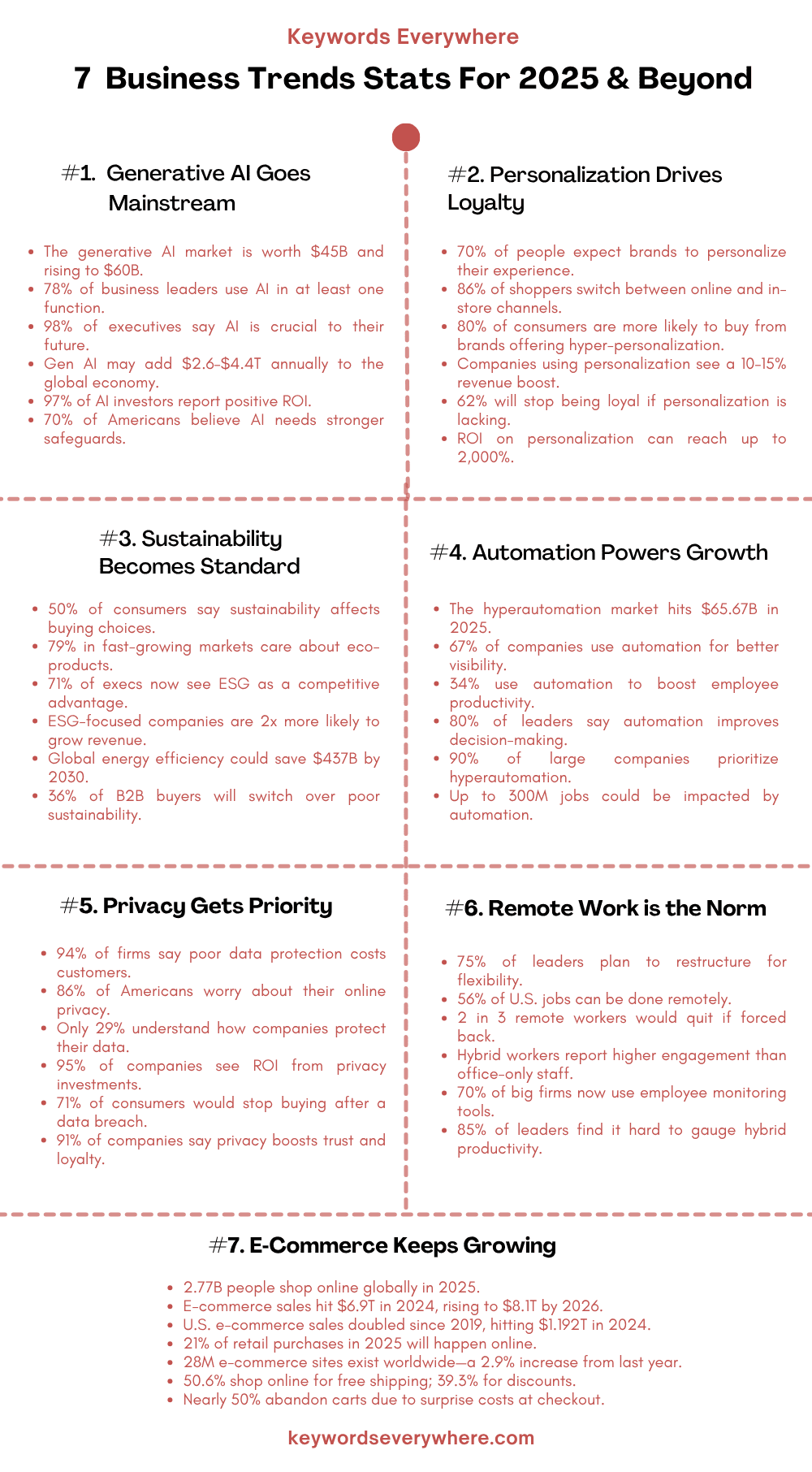
#1. Generative AI Becomes a Business Essential
Generative AI is no longer a novelty—it’s rapidly becoming central to how businesses operate, innovate, and compete.
Whether it’s crafting content, automating customer service, designing new product prototypes, or augmenting code, organizations are embedding AI into everyday workflows.
Industry leaders are recognizing that without strategic GenAI adoption, companies risk falling behind. What’s more?
Many are also realizing that full-scale implementation requires more than technology—it also demands new skills, change management, and cultural shifts.
Let’s look at the stats that explain how Gen AI is reshaping the business world:
1. The generative AI market is already worth around $45 billion, and it’s expected to grow to about $60 billion—making up nearly a third of the entire AI industry.
2. Almost 70% of consumers now believe that most businesses will soon start using generative AI to improve their customer experience.
3. In one McKinsey study, 78% of business leaders said they’ve already added AI into at least one part of their company to stay ahead of the competition.

Companies using AI in at least one business function
4. According to Accenture, large language models (LLMs) could affect 40% of all working hours, and nearly all global executives—98%—say AI will be an important part of their company’s future.
5. Goldman Sachs predicts generative AI could raise global productivity, potentially adding 7% to the world’s GDP—that’s around $7 trillion—over the next decade.
6. A strong majority—70% of Americans and 92% of tech experts—agree that AI needs stronger safeguards to protect people as it becomes more common.
7. Ernst & Young found that 97% of senior leaders who’ve invested in AI say they’ve already seen a positive return on that investment.
8. Generative AI is also headed into advertising. Google has already announced plans to roll out AI-powered ads in the near future.
9. McKinsey & Company estimates that generative AI could add between $2.6 trillion and $4.4 trillion every year to the global economy in the near future.
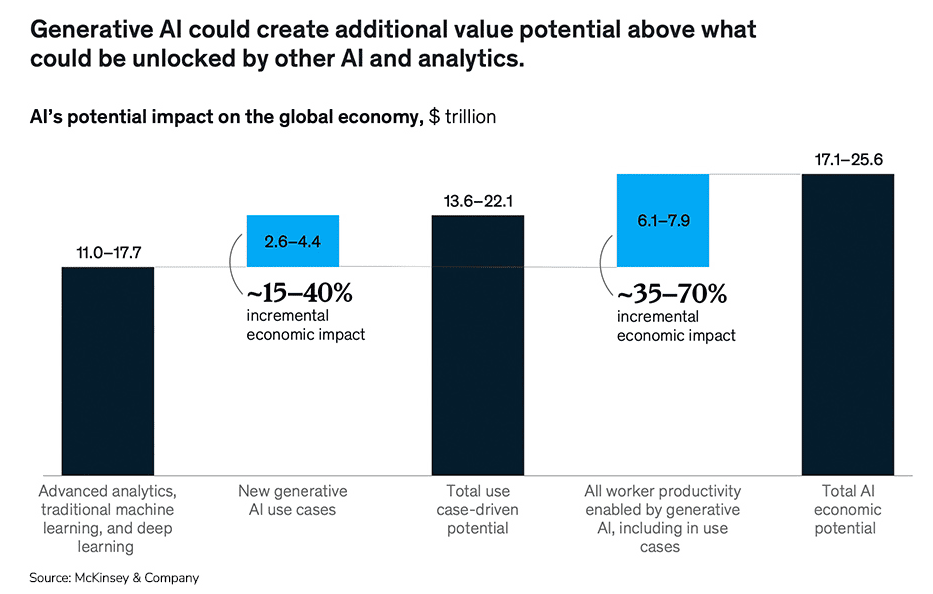
Gen AI can create additional value potential above the other AI and analytics
10. Nearly half of U.S. executives say generative AI will help boost productivity, while others say its best use is in creating content (40%) and analyzing customer interactions (31%)—especially in contact centers.
11. As AI tools become more common, some jobs may shrink. Business areas like service operations (54%), supply chain (45%), and HR (41%) are expected to see a drop in roles due to automation.
#2. Hyper-Personalization Builds Brand Loyalty
You probably already know what personalization looks like—maybe a company sends you an email with your name in the subject line or recommends a product based on something you browsed last week.
But hyper-personalization goes way beyond that.
It means the business understands your habits, preferences, and timing so well that it can adjust offers in real-time and even predict what you’ll need next before you ask for it.
You can thank AI for this. Advances in AI and data tools allow businesses to anticipate needs, dynamically adjust all their offers, and continuously refine messaging, driving deeper connection and trust with customers.
Savvy brands know that by making each customer feel uniquely understood, they earn loyalty, higher conversion, and better returns.
12. According to McKinsey, over 70% of people now expect a personalized experience when dealing with a brand, and many feel frustrated when they don’t get it.
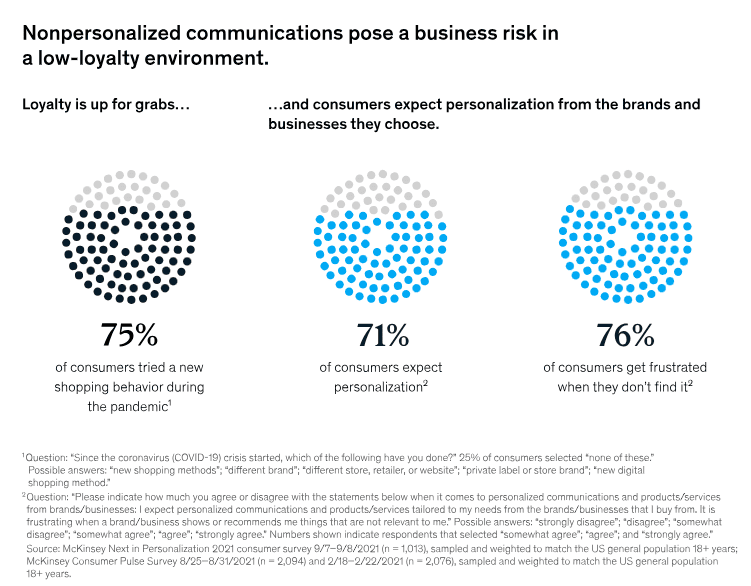
Consumers expect personalization from businesses
13. Nielsen found that 86% of shoppers move between online and in-store channels, which means businesses need to offer consistent, personalized experiences across every touchpoint—not just one or the other.
14. In Twilio’s latest State of Personalization report, 56% of consumers said a personalized experience would make them want to buy again—a noticeable jump from the previous year.
15. Around 80% of customers say they’re more likely to buy from companies that offer hyper-personalized experiences tailored to their preferences and behavior.

Consumers demand hyper personalized experiences from businesses
16. On average, companies that invest in hyper-personalization see a 10–15% revenue boost, with some reporting gains as high as 25%.
17. A generic, one-size-fits-all approach could cost you customers—62% say they’ll stop being loyal to a brand if it doesn’t personalize their experience.
18. Nearly half of the brands surveyed by eMarketer said personalized marketing helped increase their conversion rates.
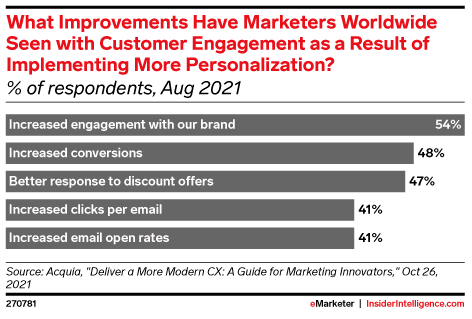
Personalization increases conversion rates
19. Done well, personalization can deliver a huge return. Reports show it can boost ROI by up to 2,000%, with typical improvements falling between 500% and 800%.
20. About 70% of brands using advanced personalization say they earn at least double their investment back, proving how powerful this strategy can be when done right.
21. Interest in hyper-personalization is clearly rising. According to Keywords Everywhere, over 4,000 people now search for it every month on Google, and that number has been growing steadily since 2020.
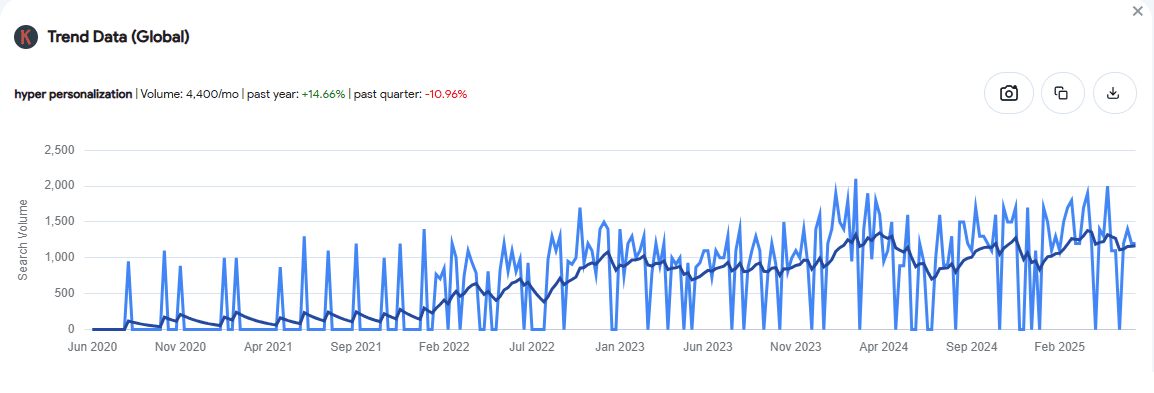
#3. Sustainability and Circular Economies Are Now Standard
Sustainability is no longer a bonus—it’s an operational and reputational imperative.
Consumers, regulators, and investors are demanding eco-friendly actions, driving companies to rethink resource use, waste, and product lifecycles.
More businesses are embracing circular models—featuring repair services, packaging take‑backs, and refurbished goods—to reduce environmental impact and open new markets.
What began as a green promise is rapidly transitioning into a core business strategy.
Here are the stats that show how and why companies are focusing on sustainability:
22. 50% of today’s consumers say sustainability is now one of the top four things they consider before making a purchase, showing that it’s no longer just a nice-to-have—it’s a deal breaker for many.
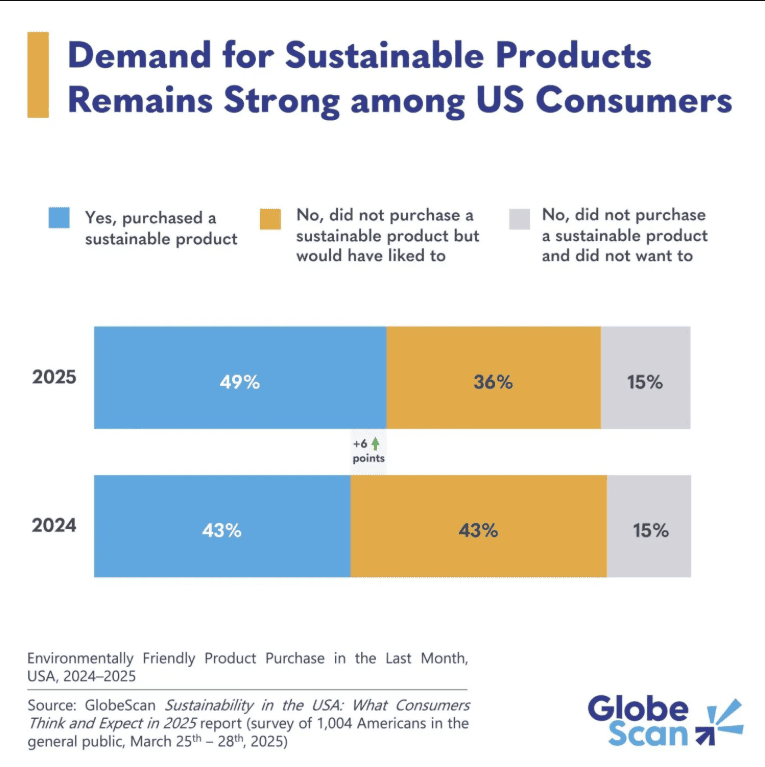
Nearly half of customers demand sustainable products from businesses
23. In fast-growing markets like China, India, and Indonesia, 79% of consumers care about environmental sustainability, while that concern drops to 55% in more developed regions like the U.S. and Europe.
24. American shoppers are willing to pay about 11% more for sustainable products, but many companies are marking those products up by an average of 28%, which can hurt trust and slow adoption.
25. Sustainability isn’t just a consumer trend—it matters in B2B too. About 36% of B2B buyers say they would switch vendors if their sustainability expectations aren’t met.
26. In 2024, 71% of C-suite executives said they see ESG efforts as a competitive advantage, which is up from 60% just a year earlier—a sign that sustainability is climbing to the top of business strategy.

C-suite executives see ESG efforts as a competitive advantage
27. Companies that successfully build ESG goals into their business strategies are seeing results—they’re twice as likely as their peers to increase revenue by 10% or more.
28. Globally, businesses could save $437 billion every year by 2030 just by improving energy efficiency.
29. By 2025, it’s expected that 11% to 15% of U.S. investment managers will allocate at least 40% of their portfolios to ESG-focused investments.
30. Bloomberg reports that 71% of business leaders now believe future investments will always factor in sustainability.
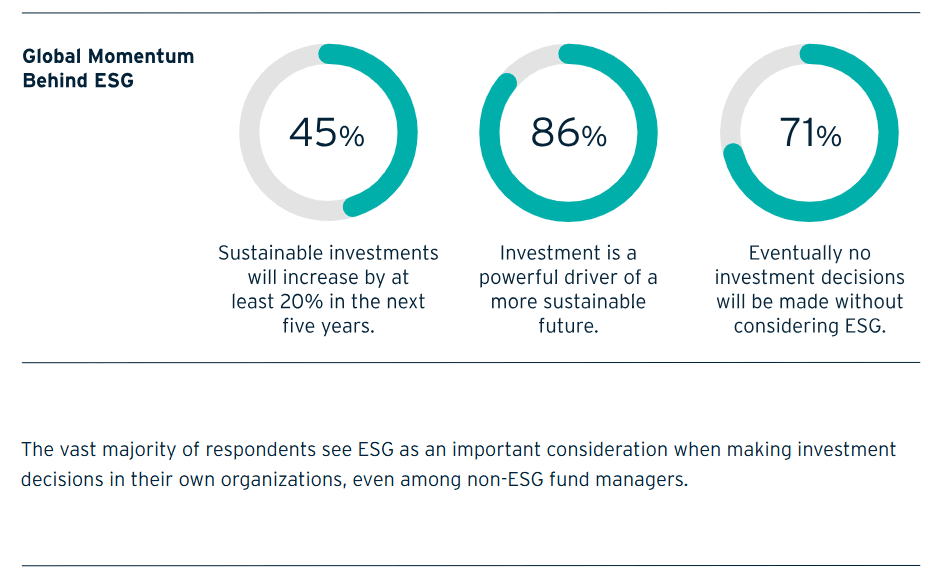
ESG is an important consideration when making investment decisions
31. Right now, only 10% of organizations use generative AI to analyze sustainability data, but over half—53%—plan to adopt this use case in the near future.
#4. Hyperautomation Transforms Operations
This year, digital transformation will take another leap forward as businesses adopt tools that turn raw, unstructured data into clear, actionable insights, making decision-making easier and more effective for leaders.
The big focus will be building ‘smart enterprises,’ where data flows effortlessly across departments.
Companies are starting to realize that just having data isn’t enough. It’s about turning that data into insights teams can act on, creating smooth feedback loops that keep everyone aligned and moving forward.
For example, Tesla uses hyperautomation in its Gigafactories, integrating robotics, IoT, and AI for predictive maintenance and production optimization.
This means machines can communicate with each other, flag issues before breakdowns happen, and adapt processes on the fly—without human involvement.
This approach helped Tesla reduce production costs per car by 30% between 2020 and 2024 and increase production efficiency by 40%, demonstrating the power of this strategy when executed effectively.
Here are the stats that show how businesses adopt automation solutions and the benefits they get from it:
32. The global hyperautomation market is growing fast. It’s worth about $65.67 billion in 2025, up from $56 billion the year before, and it’s expected to soar to over $270 billion by 2034.
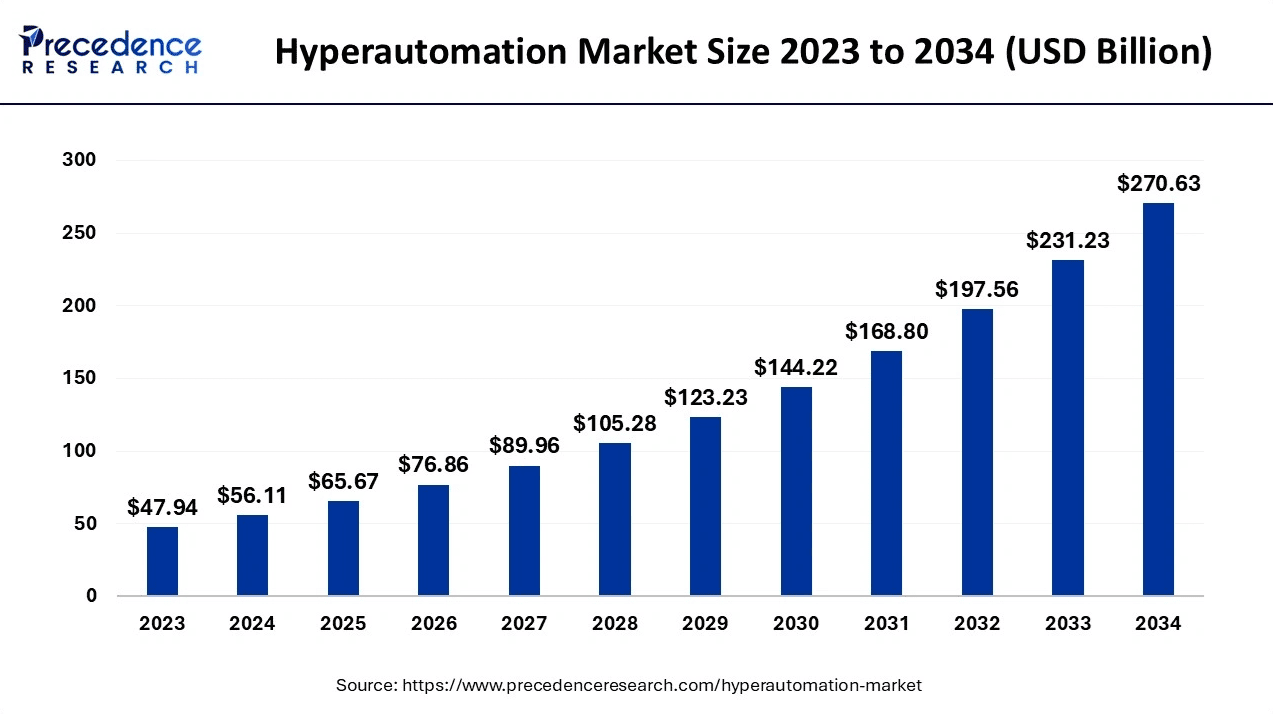
Hyperautomation market size
33. 67% of companies are using business process automation to get a clearer view of their operations across departments and systems, helping them spot issues faster and work more efficiently.
34. By 2026, 30% of enterprises are forecasted to automate over half of their network operations, up from less than 10% in 2023, according to research from Gartner—proof that automation is speeding up behind the scenes.
35. While 90% of large companies are prioritizing hyperautomation, fewer than 20% are actually tracking its impact effectively.
36. A survey of Global 500 firms found that many are choosing to invest in AI and automation tools and expect big growth from those investments in the coming years.
37. Adoption is steadily rising, with 34% of organizations using hyperautomation specifically to boost employee productivity, freeing up time from routine tasks so teams can focus on higher-value work.
38. Most business leaders—80% of them—believe automation can support better decision-making across the board, not just in IT or operations.
39. A 2024 study by Duke University revealed that nearly 60% of businesses surveyed had already rolled out automation tools.
40. However, as automation spreads, there are concerns too. Experts estimate that up to 300 million full-time jobs worldwide could be impacted by new AI-driven systems.
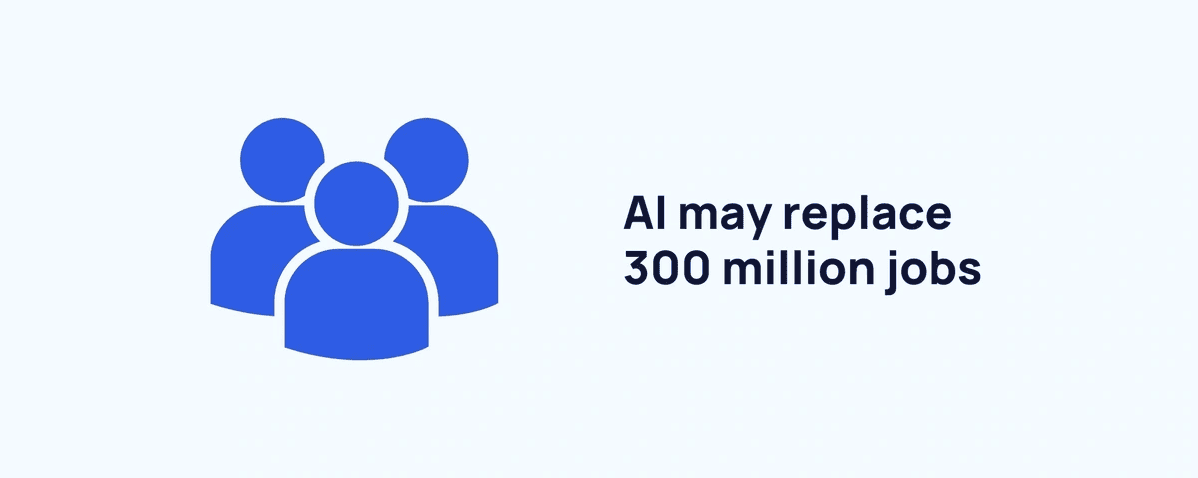
AI will replace jobs in the future
#5. Cybersecurity and Data Privacy Take Center Stage
As more business moves online, cybersecurity and privacy are no longer just technical backstops—they’re foundational strategic priorities.
With attackers growing increasingly sophisticated and attacks hitting not just IT but reputation and finances, organizations are treating data protection as a competitive edge.
They’re building systems that detect threats in real-time, training employees on phishing, and using AI to triage alarms before they turn into breaches.
Let’s look at the stats to understand how businesses are focusing on cybersecurity:
41. 94% of companies say their customers wouldn’t stick around if they didn’t protect their personal data properly.
42. In the U.S., 86% of people say they’re increasingly worried about data privacy, especially as more of their lives move online and into the cloud.

Consumers are concerned about data privacy
43. Despite all the privacy talk, only 29% of consumers feel it’s easy to understand how companies protect their data, which means most businesses still have a long way to go in building clarity and confidence.
44. 95% of companies say investing in data privacy pays off, with most seeing a return that’s 1.6x their spend—and nearly a third reporting a 2x ROI or more.
45. Mishandle data, and you’ll lose trust fast—71% of consumers say they’d stop doing business with a company if it failed to protect their sensitive information.
46. Over 94% of businesses believe it’s possible to balance collecting data for marketing while respecting customer privacy, proving that it doesn’t have to be one or the other.
47. 91% of companies say they’d prioritize data privacy even more if they knew it would directly boost customer trust and loyalty—which it often does.
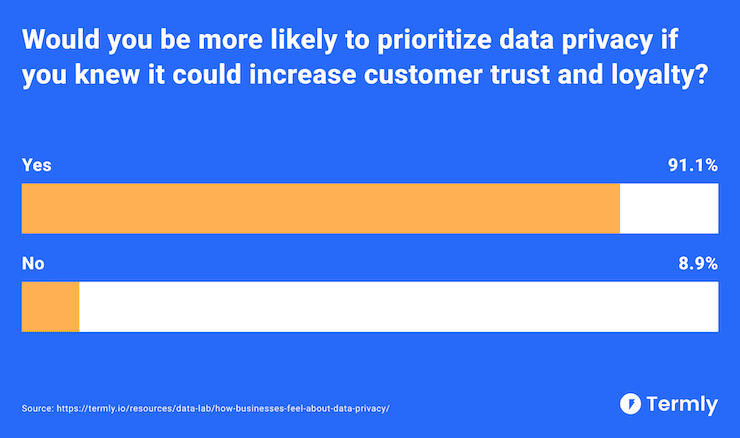
Data privacy improves customer trust and loyalty
48. In fact, over 40% of organizations see at least double the benefit from what they spend on privacy, which is why privacy is increasingly seen not as a cost—but as a smart, strategic investment.
#6. Remote and Hybrid Work Becomes the Norm
Employees want flexibility.
The shift to remote and hybrid work has evolved from a pandemic-era necessity into a core strategy for attracting talent and boosting productivity.
But it’s not just about letting people work from home; it’s about optimizing how work happens by redesigning workflows, communications, and office spaces around flexibility.
Tools like virtual whiteboards, asynchronous video updates, and distributed decision-making frameworks are becoming standard.
Let’s take a look at how and why employees are actively seeking work from home and hybrid jobs, and how can businesses benefit from this:
49. Three out of four business leaders say their company is likely to rethink or change the structure of its workplace in the next two years as flexible work becomes the new normal for many teams.
50. Employee engagement is noticeably higher among those with more freedom—37% of remote and hybrid workers report being engaged, compared to just 28% of those stuck fully on-site without flexibility.
51. According to a Gallup survey, 56% of full-time U.S. employees have jobs that can be done from home, which adds up to about 70 million workers. Among them, 50% work hybrid, 30% are fully remote, and only 20% are fully in-office—showing how common remote setups have become.

US employee work locations
52. Many remote workers aren’t willing to go back. More than two-thirds say they’d start job hunting if forced into a full-time office return, and over half would even consider taking a pay cut to keep their flexible schedule.
53. Still, managing hybrid teams isn’t always easy. Microsoft reports that 85% of business leaders say it’s hard to trust productivity levels when employees are working from different locations.
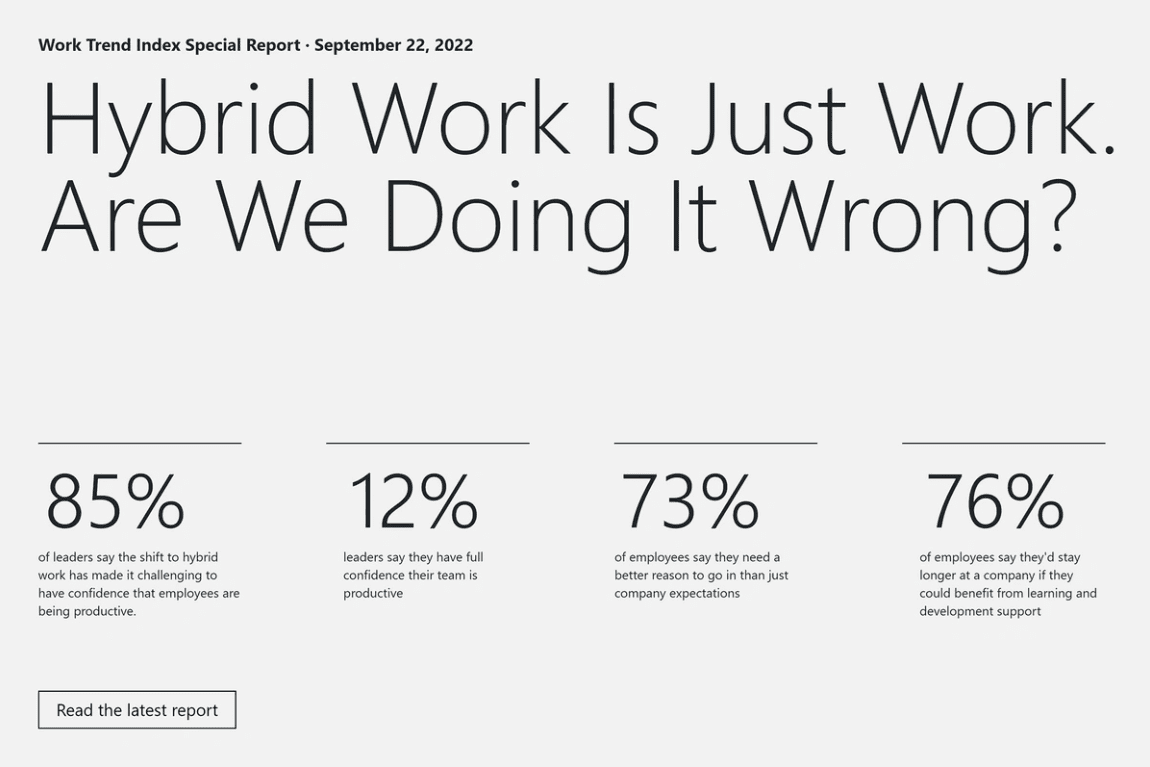
Only a few business leaders have full confidence in employee productivity in hybrid working models
54. In response, many companies are turning to digital surveillance tools. Since the pandemic, the number of large corporations using monitoring tech—like screen tracking, keystroke logging, and facial recognition—has doubled, now reaching 70%, according to Gartner.
#7. E‑Commerce Growth Isn’t Slowing Down Anytime Soon
The pandemic entirely changed how customers shop.
Even after the lockdowns ended and physical stores reopened, e‑commerce hasn’t lost its momentum—in fact, it’s still gaining ground as shopping habits continue to shift online.
What’s driving this isn’t just convenience anymore but speed, personalization, and a seamless checkout experience that meets customers where they are—on their phones, in apps, and across social platforms.
Brands that once treated online sales as a secondary channel are now prioritizing digital-first strategies, investing in faster delivery, better returns, and AI-driven recommendations.
Take Disney, for example. In early 2021, it announced it would close 60 of its brick-and-mortar stores across North America to focus more on digital sales.
Then, in late 2022, the company revealed plans to expand Disney+ to include in-app commerce—blending entertainment and shopping into a single experience that reflects where consumer attention is truly headed.
The following stats reveal how the pandemic changed eCommerce landscape and where will it go in the coming years:
55. E-commerce was already growing fast before the pandemic—but once COVID-19 hit, the growth skyrocketed. Shopify reported that online shopping saw 10 years’ worth of growth in just 3 months, as people shifted to digital buying almost overnight.
56. As of 2025, there are 2.77 billion online shoppers worldwide, meaning about one in every three people on Earth now shops online—a 2.2% jump from last year.

Number of online shoppers worldwide
57. In 2024, global e-commerce sales reached $6.9 trillion, and that number is expected to climb to $8.1 trillion by 2026, proving that this isn’t just a short-term trend—it’s the future of retail.
58. U.S. e-commerce sales hit $1.192 trillion in 2024, which is more than double what they were in 2019, showing steady growth since the early pandemic surge.
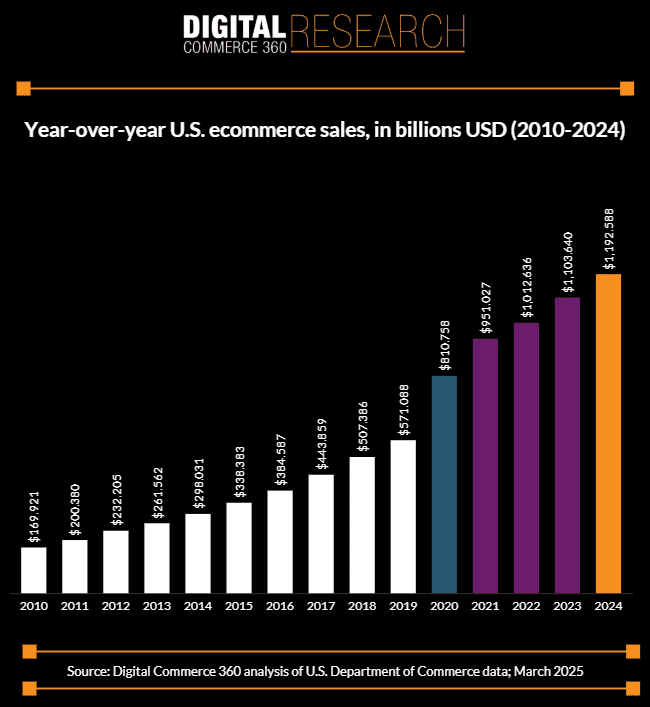
US eCommerce sales 2010-2024
59. Over $500 billion of those 2024 U.S. sales came from just two major retailers, showing how dominant the top players have become in the online space.
60. In 2025, 21% of all retail purchases will happen online—the highest share yet. That number is expected to rise to 22.6% by 2027, growing steadily by about 0.32% each year.
61. There are now 28 million e-commerce sites globally, up 2.9% from last year. That means roughly 2,160 new e-commerce websites launch every single day.
62. When it comes to how people start shopping, 44% begin with a search engine, while 41% go straight to platforms like Amazon or brand websites—making visibility across platforms more important than ever.
63. Free shipping is the top reason people shop online (50.6%), followed by discounts and coupons (39.3%), showing that convenience and savings still drive digital buying decisions.
64. But checkout is still a pain point. Nearly half of U.S. shoppers abandon their carts when unexpected costs like taxes or shipping pop up. Others leave if they have to create an account (25%) or if the delivery is too slow (24%).

Top reasons why consumers abandon their online orders during the checkout process
65. Many e-commerce businesses are now automating key processes, and it’s paying off—companies report an 80% increase in lead generation and a 45% increase in ROI by using automation tools to streamline operations.
Conclusion
That wraps up our deep dive into the top business trends stats shaping 2025 and beyond.
From AI-powered tools and hyper-personalized experiences to the ongoing growth of e-commerce and rising expectations around sustainability, it’s clear that businesses are entering a fast-moving, tech-driven era.
At the same time, customer trust, data privacy, and workplace flexibility are becoming just as important as innovation itself.
Companies that stay ahead of these shifts—and adapt with clarity and purpose—will be the ones that lead the way in the years to come.


